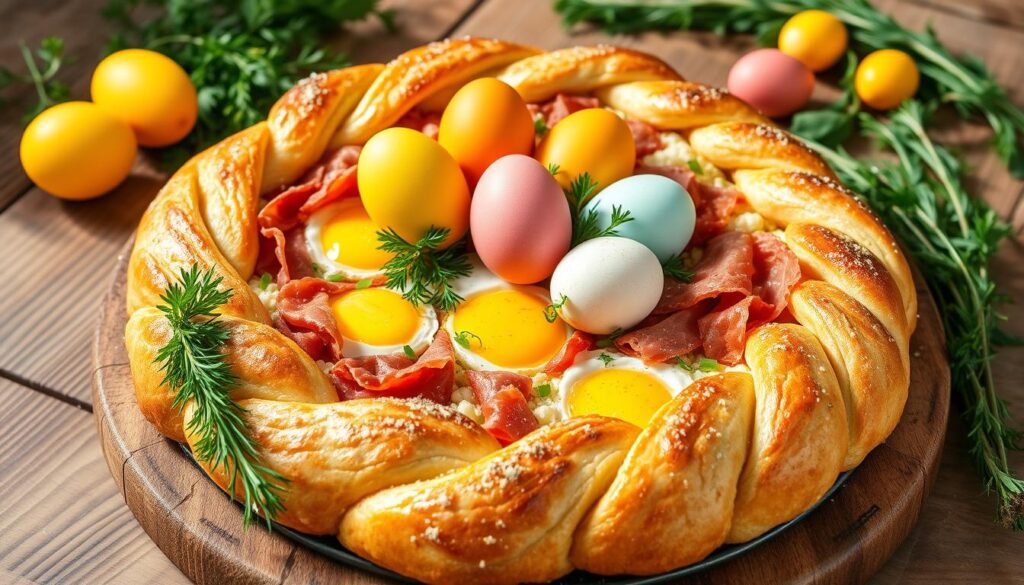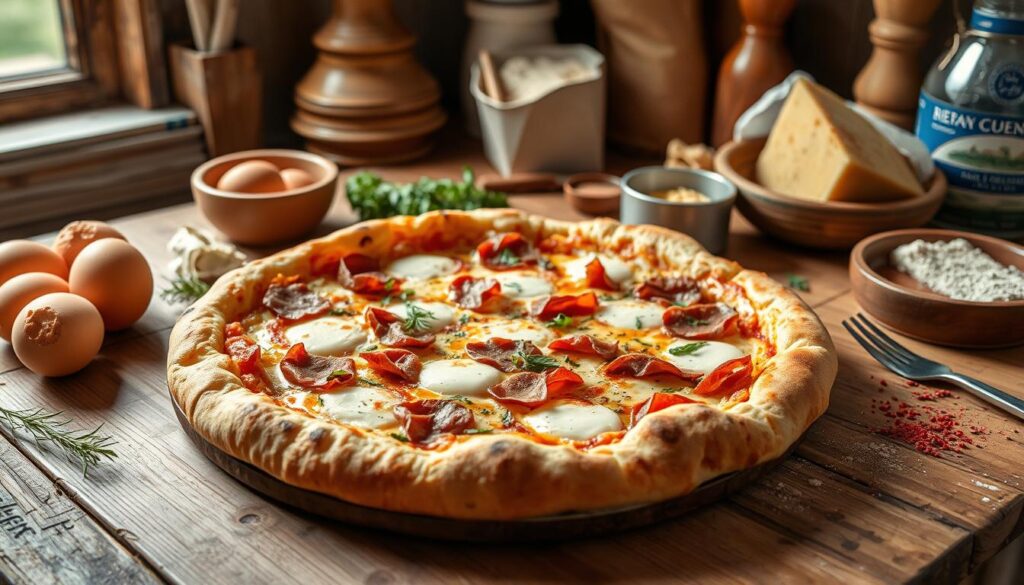Discover the secrets of traditional Italian Easter pie with this classic pizza rustica recipe. It comes from Naples in the 17th century. This savory dish has been a favorite at Easter for many years.
It marks the end of Lenten fasting. Pizza rustica is a rich dish that brings people together. It celebrates the joy of Easter.
This pie has a flaky crust and is filled with eggs, cheeses, and cured meats. Each slice is a taste of Italian tradition. Whether it’s a family tradition or a new discovery, it’s a culinary adventure.
It’s perfect for your Easter table. It will delight your loved ones with its iconic flavors.
Table of Contents
The Rich History of Italian Easter Pie
Pizzagaina, also known as Pizza Rustica or Easter Pie, is a beloved dish in Italian homes. It’s especially enjoyed during Easter. This savory pie has a long history, starting in 17th century Southern Italy.
It began as a simple peasant dish. Over time, it became a symbol of abundance and celebration. It’s now a favorite at religious festivals and family gatherings.
Origins in 17th Century Naples
Pizzagaina’s roots are in Naples’ culinary traditions. It was created to celebrate the end of Lent and the start of spring. The pie’s ingredients, like pastry, meats, cheeses, eggs, and spices, symbolize new life and harvest bounty.
Significance in Easter Celebrations
As Pizzagaina became more popular, it became tied to Easter. Its rich filling was a feast after 40 days of fasting. It celebrated the season’s abundance and joy.
Evolution Through Immigration
Italian immigrants brought Pizzagaina to the United States. They adapted the recipe with local ingredients like ham and pepperoni. This change made the traditional Italian recipe accessible to more people. It became a beloved Easter brunch dish.
Essential Ingredients for the Perfect Pizza Rustica Recipe
Making a true ricotta pie or meat and cheese pie begins with the right ingredients. The traditional Pizza Rustica recipe needs a flaky pastry crust, a rich filling, and a mix of Italian cured meats and cheeses.
The Pasta Frolla, an Italian shortcrust pastry, is the base of the dish. This dough can be made in just 5 minutes. It can be kept in the fridge for up to 2 days or frozen for 3 months, making it easy to have ready.
For the filling, you’ll need:
- 32 ounces of whole-milk ricotta cheese
- 8 large eggs
- 1-½ cups of diced Italian deli meats, such as ham, salami, pepperoni, soppressata, mortadella, or prosciutto
- 1 cup of shredded mozzarella cheese
- 1 cup of diced provolone cheese
This mix of cheeses and cured meats makes the Pizza Rustica special. The filling is baked in a 375ºF oven for 50-60 minutes. This makes the top golden and the inside puffed up.
| Ingredient | Quantity |
|---|---|
| Whole-milk ricotta cheese | 32 ounces |
| Large eggs | 8 |
| Italian deli meats (diced) | 1-½ cups |
| Mozzarella cheese (shredded) | 1 cup |
| Provolone cheese (diced) | 1 cup |
Understanding the Traditional Crust and Filling Components
The heart of an authentic Easter bread pie, or baked Italian dish, lies in its crust and filling. To make a true Pizza Rustica, you need the right mix of ingredients and techniques.
Making the Perfect Pastry Crust
The crust of Pizza Rustica is usually made with buttery dough. Some recipes use olive oil instead. The dough must chill for at least an hour, or even overnight. This makes it easier to roll out and shape into the pie pan.
Selecting and Preparing Meats
The filling of the Easter bread pie includes cured meats like salami, prosciutto, and pancetta. Cut these into small cubes or chop them coarsely. This ensures they’re evenly spread in the filling.
Choosing the Right Cheese Combination
A blend of ricotta, mozzarella, and hard Italian cheeses like Pecorino Romano or Parmigiano-Reggiano makes the base creamy. The egg mixture holds everything together, giving it a quiche-like texture.
| Ingredient | Quantity |
|---|---|
| Large Eggs | 9 |
| Whole-Milk Ricotta Cheese | 15 ounces |
| Mozzarella Cheese | 1 pound |
| Cubed Dry Salami | 2 cups |
| Thinly Sliced Hard Salami | 1/4 pound |
| Sliced Provolone Cheese | 1/4 pound |
| Thinly Sliced Prosciutto | 4 thin slices |
Choosing and preparing these ingredients right is key to the Easter bread pie‘s true taste and texture.

Step-by-Step Pizza Rustica Preparation Guide
Preparing the traditional Italian Easter pie recipe, or Pizza Rustica, is a delightful culinary adventure. Start by preheating your oven to 350°F (175°C). In a large bowl, whisk together beaten eggs and creamy ricotta until smooth and well-combined. Next, gently fold in cubed meats, such as prosciutto, salami, and capicola, along with your choice of shredded mozzarella and Parmesan cheeses. Season the filling with a pinch of salt and freshly ground black pepper to taste.
Line a deep-dish pie plate or springform pan with a layer of your homemade or store-bought pastry dough, pressing it firmly into the sides and bottom. Carefully pour the savory filling mixture into the prepared crust, ensuring an even distribution. Top the filling with a second layer of dough, sealing the edges tightly. Use a sharp knife to make a small incision or slit in the center of the top crust to allow steam to escape during baking.
Brush the top of the pizza rustica with a beaten egg wash, giving it a beautiful golden-brown sheen. Bake the pie for approximately 60-75 minutes, or until the crust is a deep golden color and the filling is bubbling. Once done, remove the pie from the oven and allow it to cool completely before slicing and serving.
Traditionally, Pizza Rustica is enjoyed at room temperature, making it the perfect Easter Monday picnic or celebration dish. Savor the layers of savory goodness, from the flaky crust to the creamy ricotta and melted cheeses, punctuated by the flavors of cured meats. This Italian Easter pie recipe is sure to delight your taste buds and become a cherished family tradition.
Tips for Mastering Your Easter Pie
Making the perfect Pizza Rustica, or Italian Easter pie, requires practice. But with a few simple tips, you’ll get it right in no time. First, don’t overfill the crust. This can cause leaks and make a mess. Make sure to seal the edges well to avoid spills.
Common Mistakes to Avoid
- Overfilling the crust, leading to leaks
- Failing to properly seal the edges of the pie
- Undercooked or tough wheat berries in the filling
Storage and Make-Ahead Instructions
For the best taste, make your Easter pie tips a day before and chill it overnight. This lets the flavors mix and the crust get firmer. Your pizza rustica serving can stay in the fridge for up to 4 days or be frozen for 3 months.
Serving Suggestions
Enjoy your tasty Easter pie at a festive brunch or as a satisfying appetizer. It goes great with a green salad and a full-bodied Italian red wine. Wow your guests with this classic and tasty dish!
Regional Variations and Family Traditions
The traditional Pizza Rustica recipe has changed over time. It has different versions in Italy and among Italian-American families. These changes show the variety of Italian regional recipes and the family Easter traditions that have been kept alive for years.
Even though the dough and filling stay the same, some recipes add hard-boiled eggs, spinach, or artichokes. In the U.S., some families use ham instead of Italian meats. This is because of the local ingredients and tastes.
Every family has its own special mix of meats and cheeses. These are passed down through generations. These variations not only show the different cooking traditions in Italy but also the personal touch and legacy each family adds to this Easter dish.
| Regional Variations | Family Traditions |
|---|---|
| Inclusion of hard-boiled eggs Addition of spinach or artichokes Use of ham instead of traditional cured meats | Unique combinations of meats and cheeses Passing down recipes through generations Baking dozens of pies for Easter celebrations |
The Pizza Rustica recipe can be changed to fit different tastes and traditions. This shows how loved and versatile this Italian regional recipe is. It’s a big part of family Easter traditions all over the world.

Modern Adaptations and Time-Saving Methods
Traditional Pizza Rustica is a beloved Italian Easter recipe. But, busy cooks can now enjoy its flavors with modern, quick methods. By using pre-made ingredients and streamlining the assembly, you can make a tasty easy pizza rustica. It’s ideal for your time-saving Easter recipes.
Using Store-Bought Ingredients
One way to make Pizza Rustica easier is by using pre-made pie crusts or pizza dough. This cuts down the time needed for mixing and rolling. You can also use pre-diced deli meats like salami, pepperoni, and prosciutto. This skips the chopping step.
Quick Assembly Techniques
Another quick method is to layer the ingredients instead of mixing them. This lets you assemble the Pizza Rustica by placing the crust in a pan, adding fillings in a layer, and topping with another crust or a lattice pattern. This saves time and looks great.
By using these modern tips, you can enjoy Pizza Rustica‘s rich flavors without spending hours cooking. These time-saving Easter recipes make it easy to add this Italian dish to your holiday meals.
Nutritional Information and Serving Size Guidelines
The traditional pizza rustica is a tasty Italian Easter dish. But, it’s important to know about its nutritional content and serving sizes. This pie is packed with calories because of its meats, cheeses, and pastry crust.
A slice, about 1/8 of a 9-inch pie, has 500-600 calories. It’s also high in protein (around 45g per serving) and fat (about 45g total fat, 19g saturated fat) from the meats and cheeses. Plus, it has a lot of cholesterol (around 284mg per serving) and sodium (about 2,090mg per serving).
Because pizza rustica is so rich and filling, a small slice is enough for a meal. Pair it with lighter sides like fresh salads or roasted veggies to balance it out.
| Nutritional Information (per serving) | Amount |
|---|---|
| Calories | 707 |
| Total Fat | 45g |
| Saturated Fat | 19g |
| Cholesterol | 284mg |
| Sodium | 2,090mg |
| Total Carbohydrates | 28g |
| Dietary Fiber | 2g |
| Total Sugars | 3g |
| Protein | 45g |
By controlling portion sizes and adding lighter sides, you can enjoy pizza rustica without overdoing it. This way, you can still have a healthy, balanced meal.
Conclusion
Pizza Rustica is a symbol of Italy’s rich food culture and the importance of food in celebrations. It ends Lenten fasting and brings families together. The recipe has changed over time but its core remains the same.
This dish is loved by many during Easter, whether it’s the traditional recipe or a modern twist. The mix of meats, cheeses, and eggs in a flaky crust is truly satisfying. It’s a key part of Italian and Italian-American Easter celebrations.
Enjoying Pizza Rustica connects you to Italy’s culinary history and the joy of celebration. It’s a tradition worth keeping alive. Share this traditional Italian Easter food with your loved ones during the celebratory dishes of the season.

